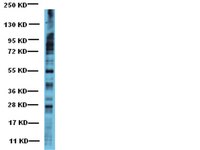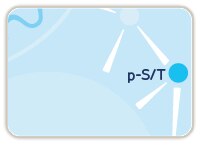Protein kinase G-regulated production of H2S governs oxygen sensing.
Yuan, G; Vasavda, C; Peng, YJ; Makarenko, VV; Raghuraman, G; Nanduri, J; Gadalla, MM; Semenza, GL; Kumar, GK; Snyder, SH; Prabhakar, NR
Science signaling
8
ra37
2015
Show Abstract
Reflexes initiated by the carotid body, the principal O2-sensing organ, are critical for maintaining cardiorespiratory homeostasis during hypoxia. O2 sensing by the carotid body requires carbon monoxide (CO) generation by heme oxygenase-2 (HO-2) and hydrogen sulfide (H2S) synthesis by cystathionine-γ-lyase (CSE). We report that O2 stimulated the generation of CO, but not that of H2S, and required two cysteine residues in the heme regulatory motif (Cys(265) and Cys(282)) of HO-2. CO stimulated protein kinase G (PKG)-dependent phosphorylation of Ser(377) of CSE, inhibiting the production of H2S. Hypoxia decreased the inhibition of CSE by reducing CO generation resulting in increased H2S, which stimulated carotid body neural activity. In carotid bodies from mice lacking HO-2, compensatory increased abundance of nNOS (neuronal nitric oxide synthase) mediated O2 sensing through PKG-dependent regulation of H2S by nitric oxide. These results provide a mechanism for how three gases work in concert in the carotid body to regulate breathing. | | 25900831
 |
A Trio-Rac1-Pak1 signalling axis drives invadopodia disassembly.
Moshfegh, Y; Bravo-Cordero, JJ; Miskolci, V; Condeelis, J; Hodgson, L
Nature cell biology
16
574-86
2014
Show Abstract
Rho family GTPases control cell migration and participate in the regulation of cancer metastasis. Invadopodia, associated with invasive tumour cells, are crucial for cellular invasion and metastasis. To study Rac1 GTPase in invadopodia dynamics, we developed a genetically encoded, single-chain Rac1 fluorescence resonance energy (FRET) transfer biosensor. The biosensor shows Rac1 activity exclusion from the core of invadopodia, and higher activity when invadopodia disappear, suggesting that reduced Rac1 activity is necessary for their stability, and Rac1 activation is involved in disassembly. Photoactivating Rac1 at invadopodia confirmed this previously unknown Rac1 function. We describe here an invadopodia disassembly model, where a signalling axis involving TrioGEF, Rac1, Pak1, and phosphorylation of cortactin, causes invadopodia dissolution. This mechanism is critical for the proper turnover of invasive structures during tumour cell invasion, where a balance of proteolytic activity and locomotory protrusions must be carefully coordinated to achieve a maximally invasive phenotype. | | 24859002
 |
Specific phosphorylation of histone demethylase KDM3A determines target gene expression in response to heat shock.
Cheng, MB; Zhang, Y; Cao, CY; Zhang, WL; Zhang, Y; Shen, YF
PLoS biology
12
e1002026
2014
Show Abstract
Histone lysine (K) residues, which are modified by methyl- and acetyl-transferases, diversely regulate RNA synthesis. Unlike the ubiquitously activating effect of histone K acetylation, the effects of histone K methylation vary with the number of methyl groups added and with the position of these groups in the histone tails. Histone K demethylases (KDMs) counteract the activity of methyl-transferases and remove methyl group(s) from specific K residues in histones. KDM3A (also known as JHDM2A or JMJD1A) is an H3K9me2/1 demethylase. KDM3A performs diverse functions via the regulation of its associated genes, which are involved in spermatogenesis, metabolism, and cell differentiation. However, the mechanism by which the activity of KDM3A is regulated is largely unknown. Here, we demonstrated that mitogen- and stress-activated protein kinase 1 (MSK1) specifically phosphorylates KDM3A at Ser264 (p-KDM3A), which is enriched in the regulatory regions of gene loci in the human genome. p-KDM3A directly interacts with and is recruited by the transcription factor Stat1 to activate p-KDM3A target genes under heat shock conditions. The demethylation of H3K9me2 at the Stat1 binding site specifically depends on the co-expression of p-KDM3A in the heat-shocked cells. In contrast to heat shock, IFN-γ treatment does not phosphorylate KDM3A via MSK1, thereby abrogating its downstream effects. To our knowledge, this is the first evidence that a KDM can be modified via phosphorylation to determine its specific binding to target genes in response to thermal stress. | | 25535969
 |
A novel high throughput biochemical assay to evaluate the HuR protein-RNA complex formation.
D'Agostino, VG; Adami, V; Provenzani, A
PloS one
8
e72426
2013
Show Abstract
The RNA binding protein HuR/ELAVL1 binds to AU-rich elements (AREs) promoting the stabilization and translation of a number of mRNAs into the cytoplasm, dictating their fate. We applied the AlphaScreen technology using purified human HuR protein, expressed in a mammalian cell-based system, to characterize in vitro its binding performance towards a ssRNA probe whose sequence corresponds to the are present in TNFα 3' untranslated region. We optimized the method to titrate ligands and analyzed the kinetic in saturation binding and time course experiments, including competition assays. The method revealed to be a successful tool for determination of HuR binding kinetic parameters in the nanomolar range, with calculated Kd of 2.5±0.60 nM, k on of 2.76±0.56*10(6) M(-1) min(-1), and k off of 0.007±0.005 min(-1). We also tested the HuR-RNA complex formation by fluorescent probe-based RNA-EMSA. Moreover, in a 384-well plate format we obtained a Z-factor of 0.84 and an averaged coefficient of variation between controls of 8%, indicating that this biochemical assay fulfills criteria of robustness for a targeted screening approach. After a screening with 2000 small molecules and secondary verification with RNA-EMSA we identified mitoxantrone as an interfering compound with rHuR and TNFα probe complex formation. Notably, this tool has a large versatility and could be applied to other RNA Binding Proteins recognizing different RNA, DNA, or protein species. In addition, it opens new perspectives in the identification of small-molecule modulators of RNA binding proteins activity. | Western Blotting | 23951323
 |
Phosphoproteomic analyses reveal signaling pathways that facilitate lytic gammaherpesvirus replication.
Stahl, JA; Chavan, SS; Sifford, JM; MacLeod, V; Voth, DE; Edmondson, RD; Forrest, JC
PLoS pathogens
9
e1003583
2013
Show Abstract
Lytic gammaherpesvirus (GHV) replication facilitates the establishment of lifelong latent infection, which places the infected host at risk for numerous cancers. As obligate intracellular parasites, GHVs must control and usurp cellular signaling pathways in order to successfully replicate, disseminate to stable latency reservoirs in the host, and prevent immune-mediated clearance. To facilitate a systems-level understanding of phosphorylation-dependent signaling events directed by GHVs during lytic replication, we utilized label-free quantitative mass spectrometry to interrogate the lytic replication cycle of murine gammaherpesvirus-68 (MHV68). Compared to controls, MHV68 infection regulated by 2-fold or greater ca. 86% of identified phosphopeptides - a regulatory scale not previously observed in phosphoproteomic evaluations of discrete signal-inducing stimuli. Network analyses demonstrated that the infection-associated induction or repression of specific cellular proteins globally altered the flow of information through the host phosphoprotein network, yielding major changes to functional protein clusters and ontologically associated proteins. A series of orthogonal bioinformatics analyses revealed that MAPK and CDK-related signaling events were overrepresented in the infection-associated phosphoproteome and identified 155 host proteins, such as the transcription factor c-Jun, as putative downstream targets. Importantly, functional tests of bioinformatics-based predictions confirmed ERK1/2 and CDK1/2 as kinases that facilitate MHV68 replication and also demonstrated the importance of c-Jun. Finally, a transposon-mutant virus screen identified the MHV68 cyclin D ortholog as a viral protein that contributes to the prominent MAPK/CDK signature of the infection-associated phosphoproteome. Together, these analyses enhance an understanding of how GHVs reorganize and usurp intracellular signaling networks to facilitate infection and replication. | | 24068923
 |
Polo-like kinase 1 inhibits the activity of positive transcription elongation factor of RNA Pol II b (P-TEFb).
Jiang, L; Huang, Y; Deng, M; Liu, T; Lai, W; Ye, X
PloS one
8
e72289
2013
Show Abstract
Polo-like kinase 1 (Plk1) is a highly conserved Ser/Thr kinase in eukaryotes and plays a critical role in various aspects of the cell cycle. Plk1 exerts its multiple functions by phosphorylating its substrates. In this study, we found that Plk1 can interact with cyclin T1/Cdk9 complex-the main form of the positive transcription elongation complex b (P-TEFb), and its C-terminal polo-box domain is responsible for the binding. Further analysis indicated that Plk1 could phosphorylate cyclin T1 at Ser564 and inhibit the kinase activity of cyclin T1/Cdk9 complex on phosphorylation of the C-terminal domain (CTD) of RNA polymerase II. By taking the approach of luciferase assay, we demonstrated that over-expression of both wild type Plk1 and constitutively active form of Plk1 inhibits the P-TEFb dependent HIV-1 LTR transcription, while knockdown of Plk1 increases the HIV-1 LTR transcription. Consistently, the data from the HIV-1 pseudovirus reporter assay indicated that Plk1 blocks the gene expression of HIV-1 pseudovirus. Taken together, our results revealed that Plk1 negatively regulates the RNA polymerase II-dependent transcription through inhibiting the activity of cyclin T1/Cdk9 complex. | | 23977272
 |
Mutual regulation between SIAH2 and DYRK2 controls hypoxic and genotoxic signaling pathways.
Pérez, M; García-Limones, C; Zapico, I; Marina, A; Schmitz, ML; Muñoz, E; Calzado, MA
Journal of molecular cell biology
4
316-30
2012
Show Abstract
The ubiquitin E3 ligase SIAH2 is an important regulator of the hypoxic response as it leads to the ubiquitin/proteasomal degradation of prolyl hydroxylases such as PHD3, which in turn increases the stability of hypoxia-inducible factor (HIF)-1α. In the present study, we identify the serine/threonine kinase DYRK2 as SIAH2 interaction partner that phosphorylates SIAH2 at five residues (Ser16, Thr26, Ser28, Ser68, and Thr119). Phosphomimetic and phospho-mutant forms of SIAH2 exhibit different subcellular localizations and consequently change in PHD3 degrading activity. Accordingly, phosphorylated SIAH2 is more active than the wild-type E3 ligase and shows an increased ability to trigger the HIF-1α-mediated transcriptional response and angiogenesis. We also found that SIAH2 knockdown increases DYRK2 stability, whereas SIAH2 expression facilitates DYRK2 polyubiquitination and degradation. Hypoxic conditions cause a SIAH2-dependent DYRK2 polyubiquitination and degradation which ultimately also results in an impaired SIAH2 phosphorylation. Similarly, DYRK2-mediated phosphorylation of p53 at Ser46 is impaired under hypoxic conditions, suggesting a molecular mechanism underlying chemotherapy resistance in solid tumors. | | 22878263
 |
Estrous cycle variations in GABA(A) receptor phosphorylation enable rapid modulation by anabolic androgenic steroids in the medial preoptic area.
Oberlander, JG; Porter, DM; Onakomaiya, MM; Penatti, CA; Vithlani, M; Moss, SJ; Clark, AS; Henderson, LP
Neuroscience
226
397-410
2012
Show Abstract
Anabolic androgenic steroids (AAS), synthetic testosterone derivatives that are used for ergogenic purposes, alter neurotransmission and behaviors mediated by GABA(A) receptors. Some of these effects may reflect direct and rapid action of these synthetic steroids at the receptor. The ability of other natural allosteric steroid modulators to alter GABA(A) receptor-mediated currents is dependent upon the phosphorylation state of the receptor complex. Here we show that phosphorylation of the GABA(A) receptor complex immunoprecipitated by β(2)/β(3) subunit-specific antibodies from the medial preoptic area (mPOA) of the mouse varies across the estrous cycle; with levels being significantly lower in estrus. Acute exposure to the AAS, 17α-methyltestosterone (17α-MeT), had no effect on the amplitude or kinetics of inhibitory postsynaptic currents in the mPOA of estrous mice when phosphorylation was low, but increased the amplitude of these currents from mice in diestrus, when it was high. Inclusion of the protein kinase C (PKC) inhibitor, calphostin, in the recording pipette eliminated the ability of 17α-MeT to enhance currents from diestrous animals, suggesting that PKC-receptor phosphorylation is critical for the allosteric modulation elicited by AAS during this phase. In addition, a single injection of 17α-MeT was found to impair an mPOA-mediated behavior (nest building) in diestrus, but not in estrus. PKC is known to target specific serine residues in the β(3) subunit of the GABA(A) receptor. Although phosphorylation of these β(3) serine residues showed a similar profile across the cycle, as did phosphoserine in mPOA lysates immunoprecipitated with β2/β3 antibody (lower in estrus than in diestrus or proestrus), the differences were not significant. These data suggest that the phosphorylation state of the receptor complex regulates both the ability of AAS to modulate receptor function in the mPOA and the expression of a simple mPOA-dependent behavior through a PKC-dependent mechanism that involves the β(3) subunit and other sites within the GABA(A) receptor complex. | | 22989919
 |
Ser-634 and Ser-636 of Kaposi's Sarcoma-Associated Herpesvirus RTA are Involved in Transactivation and are Potential Cdk9 Phosphorylation Sites.
Tsai, WH; Wang, PW; Lin, SY; Wu, IL; Ko, YC; Chen, YL; Li, M; Lin, SF
Frontiers in microbiology
3
60
2012
Show Abstract
The replication and transcription activator (RTA) of Kaposi's sarcoma-associated herpesvirus (KSHV), K-RTA, is a lytic switch protein that moderates the reactivation process of KSHV latency. By mass spectrometric analysis of affinity purified K-RTA, we showed that Thr-513 or Thr-514 was the primary in vivo phosphorylation site. Thr-513 and Thr-514 are proximal to the nuclear localization signal ((527)KKRK(530)) and were previously hypothesized to be target sites of Ser/Thr kinase hKFC. However, substitutions of Thr with Ala at 513 and 514 had no effect on K-RTA subcellular localization or transactivation activity. By contrast, replacement of Ser with Ala at Ser-634 and Ser-636 located in a Ser/Pro-rich region of K-RTA, designated as S634A/S636A, produced a polypeptide with ∼10 kDa shorter in molecular weight and reduced transactivation in a luciferase reporter assay relative to the wild type. In contrast to prediction, the decrease in molecular weight was not due to lack of phosphorylation because the overall Ser and Thr phosphorylation state in K-RTA and S634A/S636A were similar, excluding that Ser-634 or Ser-636 motif served as docking sites for consecutive phosphorylation. Interestingly, S634A/S636A lost ∼30% immuno-reactivity to MPM2, an antibody specific to pSer/pThr-Pro motif, indicating that (634)SPSP(637) motif was in vivo phosphorylated. By in vitro kinase assay, we showed that K-RTA is a substrate of CDK9, a Pro-directed Ser/Thr kinase central to transcriptional regulation. Importantly, the capability of K-RTA in associating with endogenous CDK9 was reduced in S634A/S636A, which suggested that Ser-634 and Ser-636 may be involved in CDK9 recruitment. In agreement, S634A/S636A mutant exhibited ∼25% reduction in KSHV lytic cycle reactivation relative to that by the wild type K-RTA. Taken together, our data propose that Ser-634 and Ser-636 of K-RTA are phosphorylated by host transcriptional kinase CDK9 and such a process contributes to a full transcriptional potency of K-RTA. | | 22371709
 |
Phosphorylation of right open reading frame 2 (Rio2) protein kinase by polo-like kinase 1 regulates mitotic progression.
Liu, T; Deng, M; Li, J; Tong, X; Wei, Q; Ye, X
The Journal of biological chemistry
286
36352-60
2011
Show Abstract
Polo-like kinase 1 (Plk1) plays essential roles during multiple stages of mitosis by phosphorylating a number of substrates. Here, we report that the atypical protein kinase Rio2 is a novel substrate of Plk1 and can be phosphorylated by Plk1 at Ser-335, Ser-380, and Ser-548. Overexpression of Rio2 causes a prolonged mitotic exit whereas knockdown of Rio2 accelerates mitotic progression, suggesting that Rio2 is required for the proper mitotic progression. Overexpression of phospho-mimicking mutant Rio2 S3D but not the nonphosphorylatable mutant Rio2 S3A displays a profile similar to that of wild-type Rio2. These results indicate that the phosphorylation status of Rio2 correlates with its function in mitosis. Furthermore, time-lapse imaging data show that overexpression of Rio2 but not Rio2 S3A results in a slowed metaphase-anaphase transition. Collectively, these findings strongly indicate that the Plk1-mediated phosphorylation of Rio2 regulates metaphase-anaphase transition during mitotic progression. | | 21880710
 |






























